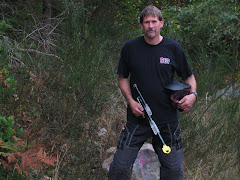I wanted to expand a little on my previous post regarding
airsoft and paintball. Mainly about what
might being through a player’s mind as he is making that bunker move I briefly
eluded to in the last post.
First, I want to start off by saying that having watched a
fair bit of airsoft now and having played as well, airsoft is very similar to
paintball. For anyone involved in either
to hate on the other would be a bit like hating on your brother for refusing to
eat tomatoes when you refuse to eat cucumbers.
In all the years I have played paintball, I have most likely
moved from one bunker to another hundreds, if not thousands of times. Although the moves differ some, they have
some common elements. There are
basically two types of bunker moves. The
first being a very casual move when a player assumes there is no one around. It’s usually done quietly and relatively slowly
so as not to attract too much attention.
Both noise and sudden movement attracts more attention. The second type of bunker move is more what I
eluded to in the last post, that being when a player wants to move from one
bunker to another but he knows one or more players on the opposing team is
aware of his presence.
What goes through my mind on this type of move is usually
something along this line and this holds true for both paintball and
airsoft. First I feel there is some
advantage or need to change positions that I know will put me in temporary
higher risk of being eliminated.
Obviously I feel the reward is worth the risk. After having made up my mind that I will make
the move, I prepare myself, knowing I will need to move quickly when the time
comes. If I am exchanging fire with one
or more opponents, will most often pop out and snap shoot at their position to
get them to duck in behind their bunker.
I then immediately make my move, hoping that the player does not pop out
from behind his bunker until I am well underway to my new position behind my
new bunker. Hopefully if my opponent
does pop out, he will not be able to get his gun up and catch up to my position
before I have successfully completed my move and regained good cover.
There is a certain amount of adrenaline involved and also
noise. I don’t worry about being quiet
on a move like this, as my opponent already knows I’m there. Obviously the objective is to make the new
bunker without being shot. Since the
adrenaline is pumping and my own running and breathing is creating noise,
sometimes I may feel something or think I may have felt a hit but am not 100%
sure. Of course I never stop mid-move,
as then I know I’m going to get hit for sure many more times, so I continue on
until I get to my new bunker.
Here’s where the big difference in paintball and airsoft
comes in. When playing paintball, upon
arriving at my bunker, I take a look for or feel for paint to see if I did
indeed feel a hit and if that hit broke.
If there is paint, obviously I call myself out, usually followed by a
complimentary, )Good shot” shout out to my opponent. However in airsoft, there is no tell-tale
sign of a possible hit during the move.
The best I can do is try to relive the run and the feeling in my mind
upon arrival at the new bunker and if I think that there was an actual hit, I
will call myself out. But...if I’m not
sure if I was hit, I don’t call myself out.
I am quite sure that this would be very similar to how most
paintball players and airsoft players act in similar situations and the reason
airsoft players make their bunker moves successfully at a higher rate than
paintball players, even though they are more weighed down and have more shots
coming at them from guns that are more accurate than paintball guns. It’s not that airsoft players necessarily cheat
more than paintball players, it’s just that there is a lot more uncertainty
about whether there was a hit or not. If
uncertain, the tie goes to the runner.


No comments:
Post a Comment